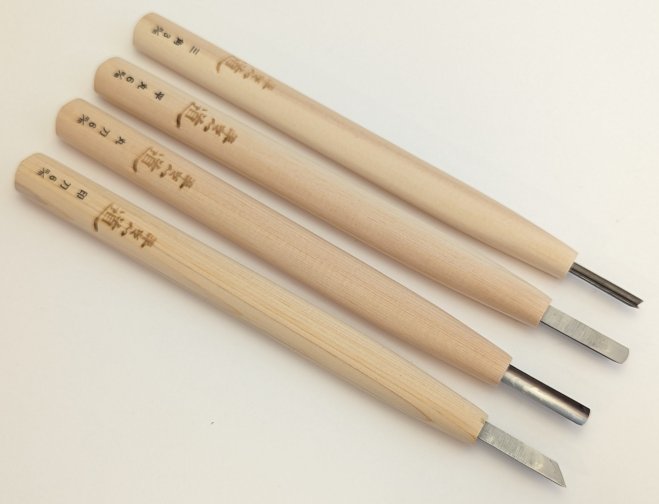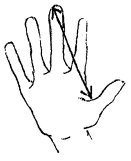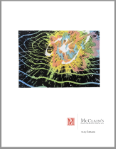
Aogami Moku Hanga To - from bottom to top:
Sho To (knife),
Maru To (u-gouge),
Hira To (chisel),
Sankaku To (v-gouge).
NEW! Aogami Moku Hanga To: Standard Carving Tools from Michihamono
McClain’s has historically carried tools from only one group of Japanese craftspeople, but we are excited to offer our customers a line of carving tools from a manufacturer new to us: Michihamono. Based in Miki City, an area with a long and rich history of tool manufacturing, Michihamono is a well-established brand which blends traditional craftsmanship with contemporary standards and technology.
While Michihamono manufactures a number of tool lines, these are their "cutlery steel carving knives" which we are calling Aogami Moku Hanga To. These are very good quality tools for students and experienced printmakers alike. In Japan these versatile carving tools are used by relief carvers, sculptors and furniture makers as well as woodblock carvers.
Following traditional manufacturing techniques, the blades of Aogami Moku Hanga To are made by forge-welding hard steel (Yasuki #2 Blue steel) to soft iron (mild steel in this case). This forging process is done by machine, which allows for precision and also makes these tools a more affordable choice than our hand-forged tools. After forging, the blades are shaped and sharpened by hand, as are all of the Japanese tools we carry.
This forge-welding process provides Aogami Moku Hanga To with a keen cutting edge that can be easily re-sharpened. The long 8cm blade (characteristic of high-quality carving tools) ensures that the tool can be sharpened many times, and when the blade gets shorter the handle can simply be whittled down to expose more usable blade (the same way one would sharpen a pencil).
The handles of the tools are made of hinoki (Japanese cypress) and are manufactured in two parts to ensure the blades are mounted straight. The oval shape of the handles is comfortable to hold and helps the carver find the correct position for cutting. They are also less apt to roll off the table.
One notable feature of Michihamono tools is their anti-rust coating. The blades of these tools are coated with a thin layer of shellac, so if you live in a rust-prone area like Hawaii or Florida they may be a good choice for you. If you find this coating interferes with cutting it can easily be removed by honing or with a solvent, but it will also be gradually polished from the tip of the blade through the carving process.
Compared to Josei and Namisei Hira To (straight sided chisels), the Aogami Hira To come with a bull-nose shape similar to our Futatsu Wari Aisuki (professional bull-nose chisel). One exception is the 15.0mm Aogami Hira To which is kept straight so it can be used to carve Kento.

The total length of these tools is about 8 inches, and the length of the blade (which is partially embedded in the handle) is 8cm (3 3/8”). Many artists cut down the handles so the tools fit comfortably in their hand. Measure from the web between the first finger and thumb to the top of the middle finger, and cut the tool to this length. If in doubt, cut long; you can always cut the handle shorter in the future.
Aogami Moku Hanga To are made for hand carving, not for use with a mallet. It is a common misconception that long-handled Japanese tools are meant to be used with a mallet, but this is not the case and they will be damaged if misused. See our Moku Hanga Nomi tools if you are looking for carving tools designed to be used with a Kizuchi (mallet).

